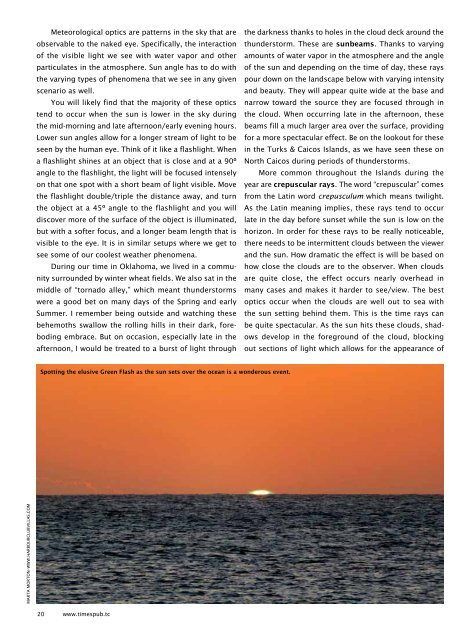Times of the Islands Fall 2020
Presents the "soul of the Turks & Caicos Islands" with in-depth features about local people, culture, history, environment, businesses, resorts, restaurants and activities.
Presents the "soul of the Turks & Caicos Islands" with in-depth features about local people, culture, history, environment, businesses, resorts, restaurants and activities.
Create successful ePaper yourself
Turn your PDF publications into a flip-book with our unique Google optimized e-Paper software.
Meteorological optics are patterns in <strong>the</strong> sky that are<br />
observable to <strong>the</strong> naked eye. Specifically, <strong>the</strong> interaction<br />
<strong>of</strong> <strong>the</strong> visible light we see with water vapor and o<strong>the</strong>r<br />
particulates in <strong>the</strong> atmosphere. Sun angle has to do with<br />
<strong>the</strong> varying types <strong>of</strong> phenomena that we see in any given<br />
scenario as well.<br />
You will likely find that <strong>the</strong> majority <strong>of</strong> <strong>the</strong>se optics<br />
tend to occur when <strong>the</strong> sun is lower in <strong>the</strong> sky during<br />
<strong>the</strong> mid-morning and late afternoon/early evening hours.<br />
Lower sun angles allow for a longer stream <strong>of</strong> light to be<br />
seen by <strong>the</strong> human eye. Think <strong>of</strong> it like a flashlight. When<br />
a flashlight shines at an object that is close and at a 90º<br />
angle to <strong>the</strong> flashlight, <strong>the</strong> light will be focused intensely<br />
on that one spot with a short beam <strong>of</strong> light visible. Move<br />
<strong>the</strong> flashlight double/triple <strong>the</strong> distance away, and turn<br />
<strong>the</strong> object at a 45º angle to <strong>the</strong> flashlight and you will<br />
discover more <strong>of</strong> <strong>the</strong> surface <strong>of</strong> <strong>the</strong> object is illuminated,<br />
but with a s<strong>of</strong>ter focus, and a longer beam length that is<br />
visible to <strong>the</strong> eye. It is in similar setups where we get to<br />
see some <strong>of</strong> our coolest wea<strong>the</strong>r phenomena.<br />
During our time in Oklahoma, we lived in a community<br />
surrounded by winter wheat fields. We also sat in <strong>the</strong><br />
middle <strong>of</strong> “tornado alley,” which meant thunderstorms<br />
were a good bet on many days <strong>of</strong> <strong>the</strong> Spring and early<br />
Summer. I remember being outside and watching <strong>the</strong>se<br />
behemoths swallow <strong>the</strong> rolling hills in <strong>the</strong>ir dark, foreboding<br />
embrace. But on occasion, especially late in <strong>the</strong><br />
afternoon, I would be treated to a burst <strong>of</strong> light through<br />
<strong>the</strong> darkness thanks to holes in <strong>the</strong> cloud deck around <strong>the</strong><br />
thunderstorm. These are sunbeams. Thanks to varying<br />
amounts <strong>of</strong> water vapor in <strong>the</strong> atmosphere and <strong>the</strong> angle<br />
<strong>of</strong> <strong>the</strong> sun and depending on <strong>the</strong> time <strong>of</strong> day, <strong>the</strong>se rays<br />
pour down on <strong>the</strong> landscape below with varying intensity<br />
and beauty. They will appear quite wide at <strong>the</strong> base and<br />
narrow toward <strong>the</strong> source <strong>the</strong>y are focused through in<br />
<strong>the</strong> cloud. When occurring late in <strong>the</strong> afternoon, <strong>the</strong>se<br />
beams fill a much larger area over <strong>the</strong> surface, providing<br />
for a more spectacular effect. Be on <strong>the</strong> lookout for <strong>the</strong>se<br />
in <strong>the</strong> Turks & Caicos <strong>Islands</strong>, as we have seen <strong>the</strong>se on<br />
North Caicos during periods <strong>of</strong> thunderstorms.<br />
More common throughout <strong>the</strong> <strong>Islands</strong> during <strong>the</strong><br />
year are crepuscular rays. The word “crepuscular” comes<br />
from <strong>the</strong> Latin word crepusculum which means twilight.<br />
As <strong>the</strong> Latin meaning implies, <strong>the</strong>se rays tend to occur<br />
late in <strong>the</strong> day before sunset while <strong>the</strong> sun is low on <strong>the</strong><br />
horizon. In order for <strong>the</strong>se rays to be really noticeable,<br />
<strong>the</strong>re needs to be intermittent clouds between <strong>the</strong> viewer<br />
and <strong>the</strong> sun. How dramatic <strong>the</strong> effect is will be based on<br />
how close <strong>the</strong> clouds are to <strong>the</strong> observer. When clouds<br />
are quite close, <strong>the</strong> effect occurs nearly overhead in<br />
many cases and makes it harder to see/view. The best<br />
optics occur when <strong>the</strong> clouds are well out to sea with<br />
<strong>the</strong> sun setting behind <strong>the</strong>m. This is <strong>the</strong> time rays can<br />
be quite spectacular. As <strong>the</strong> sun hits <strong>the</strong>se clouds, shadows<br />
develop in <strong>the</strong> foreground <strong>of</strong> <strong>the</strong> cloud, blocking<br />
out sections <strong>of</strong> light which allows for <strong>the</strong> appearance <strong>of</strong><br />
Spotting <strong>the</strong> elusive Green Flash as <strong>the</strong> sun sets over <strong>the</strong> ocean is a wonderous event.<br />
MARTA MORTON–WWW.HARBOURCLUBVILLAS.COM<br />
20 www.timespub.tc

















